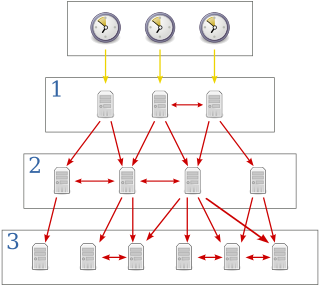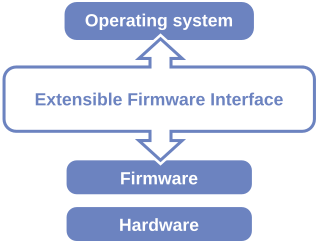Related Research Articles

Eric Steven Raymond, often referred to as ESR, is an American software developer, open-source software advocate, and author of the 1997 essay and 1999 book The Cathedral and the Bazaar. He wrote a guidebook for the Roguelike game NetHack. In the 1990s, he edited and updated the Jargon File, published as The New Hacker's Dictionary.

The Network Time Protocol (NTP) is a networking protocol for clock synchronization between computer systems over packet-switched, variable-latency data networks. In operation since before 1985, NTP is one of the oldest Internet protocols in current use. NTP was designed by David L. Mills of the University of Delaware.

Revolution OS is a 2001 documentary film that traces the twenty-year history of GNU, Linux, open source, and the free software movement.
Criticism of Microsoft has followed various aspects of its products and business practices. Issues with ease of use, robustness, and security of the company's software are common targets for critics. In the 2000s, a number of malware mishaps targeted security flaws in Windows and other products. Microsoft was also accused of locking vendors and consumers in to their products, and of not following or complying with existing standards in its software. Total cost of ownership comparisons between Linux and Microsoft Windows are a continuous point of debate.

The Unified Extensible Firmware Interface (UEFI) is a publicly available specification that defines a software interface between an operating system and platform firmware. UEFI replaces the legacy Basic Input/Output System (BIOS) firmware interface originally present in all IBM PC-compatible personal computers, with most UEFI firmware implementations providing support for legacy BIOS services. UEFI can support remote diagnostics and repair of computers, even with no operating system installed.
The SCO–Linux disputes were a series of legal and public disputes between the software company SCO Group (SCO) and various Linux vendors and users. The SCO Group alleged that its license agreements with IBM meant that source code IBM wrote and donated to be incorporated into Linux was added in violation of SCO's contractual rights. Members of the Linux community disagreed with SCO's claims; IBM, Novell and Red Hat filed claims against SCO.

Free and open-source software (FOSS) is software that is both free software and open-source software where anyone is freely licensed to use, copy, study, and change the software in any way, and the source code is openly shared so that people are encouraged to voluntarily improve the design of the software. This is in contrast to proprietary software, where the software is under restrictive copyright licensing and the source code is usually hidden from the users.
Free/open-source software – the source availability model used by free and open-source software (FOSS) – and closed source are two approaches to the distribution of software.
Open-source software development (OSSD) is the process by which open-source software, or similar software whose source code is publicly available, is developed by an open-source software project. These are software products available with its source code under an open-source license to study, change, and improve its design. Examples of some popular open-source software products are Mozilla Firefox, Google Chromium, Android, LibreOffice and the VLC media player.
Linux adoption is the adoption of Linux computer operating systems (OS) by households, nonprofit organizations, businesses, and governments.
Microsoft is a multinational computer technology corporation. Microsoft was founded on April 4, 1975, by Bill Gates and Paul Allen in Albuquerque, New Mexico. Its current best-selling products are the Microsoft Windows operating system; Microsoft Office, a suite of productivity software; Xbox, a line of entertainment of games, music, and video; Bing, a line of search engines; and Microsoft Azure, a cloud services platform.

The criticism of Linux focuses on issues concerning use of operating systems which use the Linux kernel.

In the 1950s and 1960s, computer operating software and compilers were delivered as a part of hardware purchases without separate fees. At the time, source code, the human-readable form of software, was generally distributed with the software providing the ability to fix bugs or add new functions. Universities were early adopters of computing technology. Many of the modifications developed by universities were openly shared, in keeping with the academic principles of sharing knowledge, and organizations sprung up to facilitate sharing. As large-scale operating systems matured, fewer organizations allowed modifications to the operating software, and eventually such operating systems were closed to modification. However, utilities and other added-function applications are still shared and new organizations have been formed to promote the sharing of software.
Linux began in 1991 as a personal project by Finnish student Linus Torvalds: to create a new free operating system kernel. The resulting Linux kernel has been marked by constant growth throughout its history. Since the initial release of its source code in 1991, it has grown from a small number of C files under a license prohibiting commercial distribution to the 4.15 version in 2018 with more than 23.3 million lines of source code, not counting comments, under the GNU General Public License v2.
The Microsoft Open Specification Promise is a promise by Microsoft, published in September 2006, to not assert its patents, in certain conditions, against implementations of a certain list of specifications.
"Embrace, extend, and extinguish" (EEE), also known as "embrace, extend, and exterminate", is a phrase that the U.S. Department of Justice found that was used internally by Microsoft to describe its strategy for entering product categories involving widely used standards, extending those standards with proprietary capabilities, and then using those differences in order to strongly disadvantage its competitors.
Fear, uncertainty, and doubt is a propaganda tactic used in sales, marketing, public relations, politics, polling and cults. FUD is generally a strategy to influence perception by disseminating negative and dubious or false information and a manifestation of the appeal to fear.

A Unix-like operating system is one that behaves in a manner similar to a Unix system, although not necessarily conforming to or being certified to any version of the Single UNIX Specification. A Unix-like application is one that behaves like the corresponding Unix command or shell. There is no technical standard defining the term, and opinions can differ about whether or the degree to which a particular operating system or application is Unix-like.

Visual Studio Code, also commonly referred to as VS Code, is a source-code editor made by Microsoft for Windows, Linux and macOS. Features include support for debugging, syntax highlighting, intelligent code completion, snippets, code refactoring, and embedded Git. Users can change the theme, keyboard shortcuts, preferences, and install extensions that add additional functionality.
Microsoft, a technology company historically known for its opposition to the open source software paradigm, turned to embrace the approach in the 2010s. From the 1970s through 2000s under CEOs Bill Gates and Steve Ballmer, Microsoft viewed the community creation and sharing of communal code, later to be known as free and open source software, as a threat to its business, and both executives spoke negatively against it. In the 2010s, as the industry turned towards cloud, embedded, and mobile computing—technologies powered by open source advances—CEO Satya Nadella led Microsoft towards open source adoption although Microsoft's traditional Windows business continued to grow throughout this period generating revenues of 26.8 billion in the third quarter of 2018, while Microsoft's Azure cloud revenues nearly doubled.
References
- 1 2 Harmon, Amy (November 3, 1998). "Internal Memo Shows Microsoft Executives' Concern Over Free Software". The New York Times. Retrieved November 5, 2011.
- 1 2 "Microsoft Responds to the Open Source Memo Regarding the Open Source Model and Linux". Windows NT Server 4.0 website. Microsoft. November 5, 1998. Archived from the original on October 13, 1999. Retrieved June 2, 2012.
- ↑ "Halloween Document 1". www.catb.org. Quote 7. Retrieved February 22, 2016.
- ↑ "Halloween Document 1". www.catb.org. Quote 5. Retrieved February 22, 2016.
- ↑ "The Open Source Initiative: Halloween Document 1". www.gnu.org. Archived from the original on October 13, 2019. Retrieved October 3, 2020.
- ↑ "The Open Source Initiative: Halloween Document 2". www.gnu.org. Archived from the original on January 28, 2020. Retrieved October 3, 2020.
- ↑ Rosenberg, Scott (November 4, 1998). "Let's Get This Straight: Microsoft's Halloween scare". Salon. Salon Media Group. Archived from the original on November 12, 2013. Retrieved June 2, 2012.
- ↑ "Plaintiff's Exhibit 6501" (PDF). Exhibits Offered by Plaintiffs on 1.11.07 and Admitted by the Court on 1.16.07. iowa.gotthefacts.org. January 16, 2007. Archived from the original (PDF) on November 7, 2007. Retrieved June 2, 2012.
- ↑ "Get the Facts: Total Cost of Ownership". Microsoft. Archived from the original (DOC) on April 11, 2007.
- ↑ "Windows 2000 Versus Linux in Enterprise Computing" (PDF). IDC. Archived (PDF) from the original on June 23, 2013.
- ↑ Galli, Peter (December 2, 2002). "Study Finds Windows Cheaper Than Linux". eWeek . Archived from the original on November 11, 2020. Retrieved November 12, 2020.